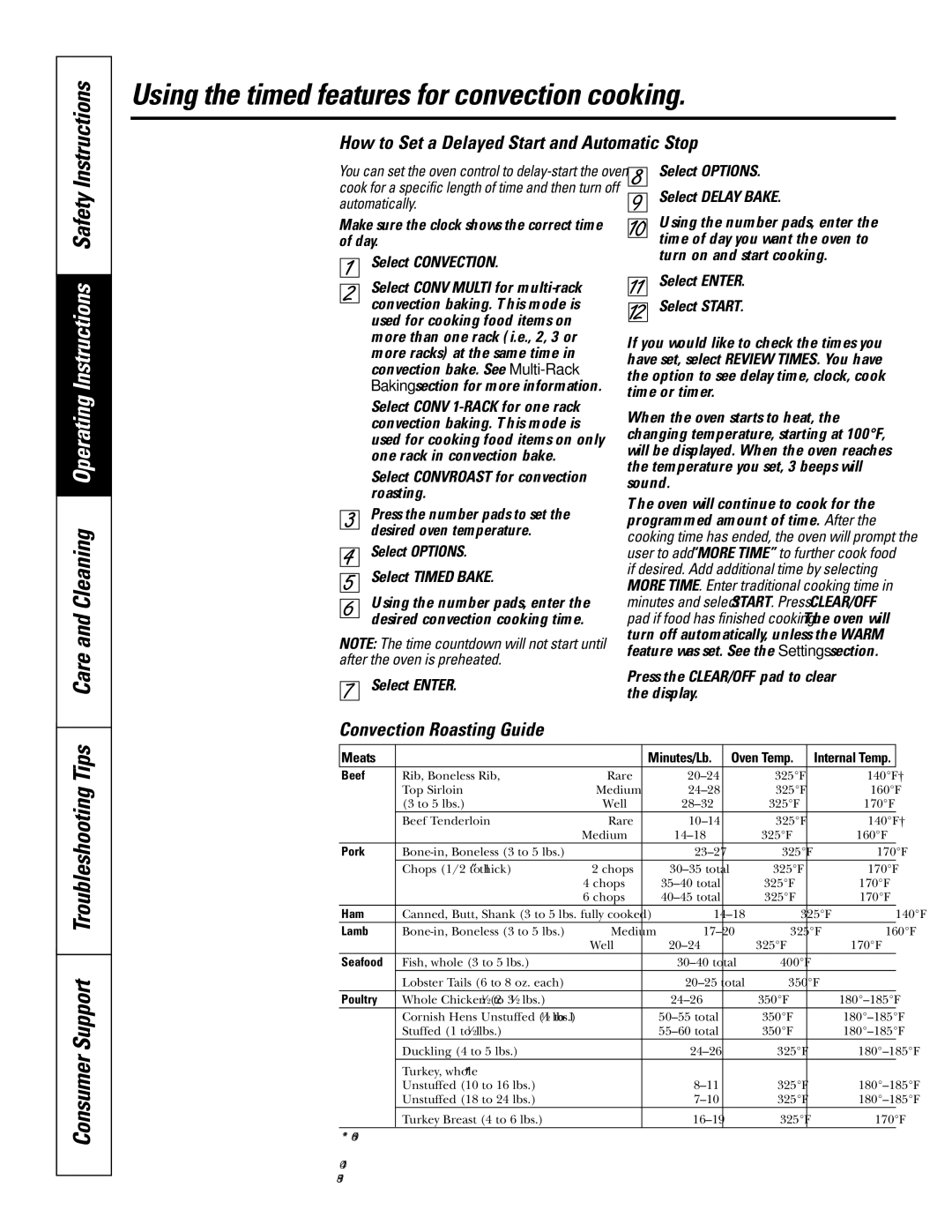
Instructions
Using the timed features for convection cooking.
How to Set a Delayed Start and Automatic Stop
Care and Cleaning Operating Instructions Safety
You can set the oven control to
Make sure the clock shows the correct time of day.
Select CONVECTION.
Select CONV MULTI for
Select CONV
Select CONVROAST for convection roasting.
Press the number pads to set the desired oven temperature.
Select OPTIONS.
Select TIMED BAKE.
Using the number pads, enter the desired convection cooking time.
NOTE: The time countdown will not start until after the oven is preheated.
Select ENTER.
Select OPTIONS.
Select DELAY BAKE.
Using the number pads, enter the time of day you want the oven to turn on and start cooking.
Select ENTER.
Select START.
If you would like to check the times you have set, select REVIEW TIMES. You have the option to see delay time, clock, cook time or timer.
When the oven starts to heat, the changing temperature, starting at 100°F, will be displayed. When the oven reaches the temperature you set, 3 beeps will sound.
The oven will continue to cook for the programmed amount of time. After the cooking time has ended, the oven will prompt the user to add “MORE TIME” to further cook food if desired. Add additional time by selecting MORE TIME. Enter traditional cooking time in minutes and select START. Press CLEAR/OFF pad if food has finished cooking. The oven will turn off automatically, unless the WARM feature was set. See the Settings section.
Press the CLEAR/OFF pad to clear the display.
Consumer Support Troubleshooting Tips
Convection Roasting Guide
| Meats |
|
| Minutes/Lb. | Oven Temp. | Internal Temp. |
| Beef | Rib, Boneless Rib, | Rare | 325°F | 140°F† | |
|
| Top Sirloin | Medium | 325°F | 160°F | |
|
| (3 to 5 lbs.) | Well | 325°F | 170°F | |
|
| Beef Tenderloin | Rare | 325°F | 140°F† | |
|
|
| Medium | 325°F | 160°F | |
| Pork |
| 325°F | 170°F | ||
|
| Chops (1/2 to 1″ thick) | 2 chops | 325°F | 170°F | |
|
|
| 4 chops | 325°F | 170°F | |
|
|
| 6 chops | 325°F | 170°F | |
| Ham | Canned, Butt, Shank (3 to 5 lbs. fully cooked) | 325°F | 140°F | ||
| Lamb | Medium | 325°F | 160°F | ||
|
|
| Well | 325°F | 170°F | |
| Seafood | Fish, whole (3 to 5 lbs.) |
| 400°F |
| |
|
| Lobster Tails (6 to 8 oz. each) |
| 350°F |
| |
| Poultry | Whole Chicken (21⁄2 to 31⁄2 lbs.) |
| 350°F | ||
|
| Cornish Hens Unstuffed (1 to 11⁄2 lbs.) |
| 350°F | ||
|
| Stuffed (1 to 11⁄2 lbs.) |
| 350°F | ||
|
| Duckling (4 to 5 lbs.) |
| 325°F | ||
|
| Turkey, whole* |
|
|
|
|
|
| Unstuffed (10 to 16 lbs.) |
| 325°F | ||
|
| Unstuffed (18 to 24 lbs.) |
| 325°F | ||
|
| Turkey Breast (4 to 6 lbs.) |
| 325°F | 170°F | |
| * Stuffed birds generally require | |||||
32 | overbrowning and drying of skin. |
|
|
|
| |
† The U.S. Department of Agriculture says “Rare beef is popular, but you should know that cooking it to only 140°F means | ||||||
some food poisoning organisms may survive.” (Source: Safe Food Book. Your Kitchen Guide. USDA Rev. June 1985.)
